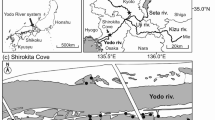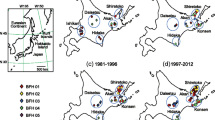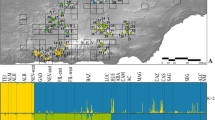Abstract
San Bernardino kangaroo rat (Dipodomys merriami parvus; SBKR), an endangered subspecies, faces ongoing anthropogenic threats such as habitat loss. Their habitat has undergone strong human-mediated fragmentation, resulting in extinction of some local populations and dramatic size reduction of the remaining populations. We examined the genetic diversity, population structure, and phylogeography of this subspecies using partial mitochrondrial DNA sequencing and microsatellite genotyping. Our study indicates that currently, the three remaining populations seem to be highly fragmented. Clear population structure and low level of haplotype sharing suggests that there has been no recent gene flow among populations, except in the case of human mediated gene flow as a result of a single translocation event. Diversity levels are on par with other species with fragmented distributions. Further, shallow phylogenetic divergence suggests the populations have not been diverged long enough to detect phylogenetic structure and separation is likely recent. Given the limited gene flow, low numbers of SBKR as evident by low return on trapping efforts, and low effective population size, habitat restoration and translocations may be warranted to maintain levels of diversity in a declining metapopulation.



Similar content being viewed by others
Change history
28 July 2020
In the Original publication of the article, Table 2 was published incorrectly. The correct Table 2 is given in this Correction.
References
Alexander LF, Riddle BR (2005) Phylogenetics of the new world rodent family Heteromyidae. J Mammal 86:366–379. https://doi.org/10.1644/BER-120.1
Avise JC, Arnold J, Ball RM et al (1987) Intraspecific phylogeography: The mitochondrial DNA bridge between population genetics and systematics. Annu Rev Ecol Syst 18:489–522. https://doi.org/10.1146/annurev.es.18.110187.002421
Ballard JWO, Rand DM (2005) The population biology of mitochondrial DNA and its phylogenetic implications. Annu Rev Ecol Evol Syst 36:621–642. https://doi.org/10.1146/annurev.ecolsys.36.091704.175513
Benjamini Y, Yekutieli D (2001) The control of the false discovery rate in multiple testing under dependency. Ann Statist 29:1165–1188. https://doi.org/10.1214/aos/1013699998
Bibby CJ, Collar NJ, Crosby MJ, et al (1992) Putting biodiversity on the map: Priority areas for global conservation. International Council for Bird Preservation
Blackhawk NC, Germano DJ, Smith PT (2016) Genetic variation among populations of the endangered Giant kangaroo rat, Dipodomys ingens, in the southern San Joaquin Valley. Am Midl Nat 175:261–274. https://doi.org/10.1674/0003-0031-175.2.261
Browning SR, Browning BL (2015) Accurate non-parametric estimation of recent effective population size from segments of identity by descent. Am J Hum Genet 97:404–418. https://doi.org/10.1016/j.ajhg.2015.07.012
Brownstein M, Carpten J, Smith J (1996) Modulation of non-templated nucleotide addition by Taq DNA polymerase: primer modifications that facilitate genotyping. Biotechniques 20:1004–1010
Caballero A, Garcia-Dorado A (2013) Allelic diversity and its implications for the rate of adaptation. Genetics 195:1373–1384. https://doi.org/10.1534/genetics.113.158410
Ceballos G, Ehrlich PR, Dirzo R (2017) Biological annihilation via the ongoing sixth mass extinction signaled by vertebrate population losses and declines. Proc Natl Acad Sci USA 114:E6089–E6096. https://doi.org/10.1073/pnas.1704949114
Chapman JR, Nakagawa S, Coltman DW et al (2009) A quantitative review of heterozygosity–fitness correlations in animal populations. Mol Ecol 18:2746–2765. https://doi.org/10.1111/j.1365-294X.2009.04247.x
Chapuis M-P, Estoup A (2007) Microsatellite null alleles and estimation of population differentiation. Mol Biol Evol 24:621–631. https://doi.org/10.1093/molbev/msl191
Chock RY, McCullough Hennessy S, Wang TB et al (2020) A multi-model approach to guide habitat conservation and restoration for the endangered San Bernardino kangaroo rat. Glob Ecol Conserv 21:e00881. https://doi.org/10.1016/j.gecco.2019.e00881
Clement M, Posada D, Crandall KA (2000) TCS: a computer program to estimate gene genealogies. Mol Ecol 9:1657–1659. https://doi.org/10.1046/j.1365-294x.2000.01020.x
Cooper LD, Randall JA (2007) Seasonal changes in home ranges of the Giant kangaroo rat (Dipodomys ingens): a study of flexible social structure. J Mammal 88:1000–1008. https://doi.org/10.1644/06-MAMM-A-197R1.1
Cornuet JM, Luikart G (1996) Description and power analysis of two tests for detecting recent population bottlenecks from allele frequency data. Genetics 144:2001–2014
Crooks KR, Burdett CL, Theobald DM et al (2017) Quantification of habitat fragmentation reveals extinction risk in terrestrial mammals. Proc Natl Acad Sci USA 114:7635–7640. https://doi.org/10.1073/pnas.1705769114
Daly M, Wilson MI, Behrends P (1986) Range use patterns and spatial relationships of Merriam’s kangaroo rats (Dipodomys Merriami). Behaviour 96:187–209. https://doi.org/10.1163/156853986X00478
Davenport A (2007) Redlands sports park San Bernardino kangaroo rat Dipdomys merriami parvus population monitoring. City of Redlands. Public Works Department, Barstow
Degnan JH, Rosenberg NA (2009) Gene tree discordance, phylogenetic inference and the multispecies coalescent. Trends Ecol Evol 24:332–340. https://doi.org/10.1016/j.tree.2009.01.009
Delaney KS, Riley SPD, Fisher RN (2010) A rapid, strong, and convergent genetic response to urban habitat fragmentation in four divergent and widespread vertebrates. PLoS ONE 5:e12767. https://doi.org/10.1371/journal.pone.0012767
Díez-del-Molino D, Sánchez-Barreiro F, Barnes I et al (2018) Quantifying temporal genomic erosion in endangered species. Trends Ecol Evol 33:176–185. https://doi.org/10.1016/j.tree.2017.12.002
Dong J, Li C, Zhang Z (2010) Density-dependent genetic variation in dynamic populations of the greater long-tailed hamster (Tscherskia triton). J Mammal 91:200–207. https://doi.org/10.1644/09-MAMM-A-098R1.1
Earl DA, vonHoldt BM (2012) STRUCTURE HARVESTER: a website and program for visualizing STRUCTURE output and implementing the Evanno method. Conserv Genet Resour 4:359–361. https://doi.org/10.1007/s12686-011-9548-7
Evanno G, Regnaut S, Goudet J (2005) Detecting the number of clusters of individuals using the software structure: a simulation study. Mol Ecol 14:2611–2620. https://doi.org/10.1111/j.1365-294X.2005.02553.x
Fisher RN, Shaffer HB (1996) The decline of amphibians in California’s great central valley. Conserv Biol 10:1387–1397. https://doi.org/10.1046/j.1523-1739.1996.10051387.x
Flint LE, Flint AL, Mendoza J et al (2018) Characterizing drought in California: new drought indices and scenario-testing in support of resource management. Ecol Process 7:1. https://doi.org/10.1186/s13717-017-0112-6
Flores-Manzanero A, Luna-Bárcenas MA, Dyer RJ, Vázquez-Domínguez E (2019) Functional connectivity and home range inferred at a microgeographic landscape genetics scale in a desert-dwelling rodent. Ecol Evol 9:437–453. https://doi.org/10.1002/ece3.4762
Frankham R (2005) Genetics and extinction. Biol Conserv 126:131–140. https://doi.org/10.1016/j.biocon.2005.05.002
Frankham R (2015) Genetic rescue of small inbred populations: meta-analysis reveals large and consistent benefits of gene flow. Mol Ecol 24:2610–2618. https://doi.org/10.1111/mec.13139
Frankham R, Bradshaw CJA, Brook BW (2014) Genetics in conservation management: revised recommendations for the 50/500 rules, Red List criteria and population viability analyses. Biol Conserv 170:56–63. https://doi.org/10.1016/j.biocon.2013.12.036
Franklin IR (1980) Evolutionary change in small populations. In: Conservation biology—an evolutionary-ecological perspective. Sinauer Associates, Sunderland, pp 135–149
Franklin IR, Allendorf FW, Jamieson IG (2014) The 50/500 rule is still valid—reply to Frankham et al. Biol Conserv 176:284–285. https://doi.org/10.1016/j.biocon.2014.05.004
Frye RJ (1983) Experimental field evidence of interspecific aggression between two species of kangaroo rat (Dipodomys). Oecologia 59:74–78. https://doi.org/10.1007/BF00388076
Germano DJ (2010) Survivorship of translocated kangaroo rats in the San Joaquin Valley. California Fish and Game, California
Goudet J (1995) FSTAT (version 1.2): a computer program to calculate F-statistics. J Hered 86:485–486. https://doi.org/10.1093/oxfordjournals.jhered.a111627
Griffith B, Scott MJ, Carpenter JW, Reed C (1989) Translocation as a species conservation tool: status and strategy. Science 245:477–479
Hanes TL, Friesen RD, Keane K (1989) Alluvial scrub vegetation in coastal southern California. USDA Forest Service Gen Tech Rep PSW-110
Hastings A (1993) Complex interactions between dispersal and dynamics: lessons from coupled logistic equations. Ecology 74:1362–1372. https://doi.org/10.2307/1940066
Huisman J, Kruuk LEB, Ellis PA et al (2016) Inbreeding depression across the lifespan in a wild mammal population. PNAS 113:3585–3590. https://doi.org/10.1073/pnas.1518046113
IUCN/SSC (2013) Guidelines for reintroductions and other conservation translocations. version 1.0. Gland, IUCN Species Survival Commission, p viiii + 57
Jakobsson M, Rosenberg NA (2007) CLUMPP: a cluster matching and permutation program for dealing with label switching and multimodality in analysis of population structure. Bioinformatics 23:1801–1806. https://doi.org/10.1093/bioinformatics/btm233
Jamieson IG, Allendorf FW (2012) How does the 50/500 rule apply to MVPs? Trends Ecol Evol 27:578–584. https://doi.org/10.1016/j.tree.2012.07.001
Johnson WE, Onorato DP, Roelke ME et al (2010) Genetic restoration of the Florida panther. Science 329:1641–1645. https://doi.org/10.1126/science.1192891
Jombart T (2008) adegenet: a R package for the multivariate analysis of genetic markers. Bioinformatics 24:1403–1405. https://doi.org/10.1093/bioinformatics/btn129
Jombart T, Devillard S, Balloux F (2010) Discriminant analysis of principal components: a new method for the analysis of genetically structured populations. BMC Genet 11:94. https://doi.org/10.1186/1471-2156-11-94
Kalinowski ST (2005) hp-rare 1.0: a computer program for performing rarefaction on measures of allelic richness. Mol Ecol Notes 5:187–189. https://doi.org/10.1111/j.1471-8286.2004.00845.x
Kocher TD, Thomas WK, Meyer A et al (1989) Dynamics of mitochondrial DNA evolution in animals: amplification and sequencing with conserved primers. PNAS 86:6196–6200. https://doi.org/10.1073/pnas.86.16.6196
Kraemer P, Gerlach G (2017) Demerelate: calculating interindividual relatedness for kinship analysis based on codominant diploid genetic markers using R. Mol Ecol Res 17:1371–1377. https://doi.org/10.1111/1755-0998.12666
Kyriazis CC, Wayne RK, Lohmueller KE (2019) High genetic diversity can contribute to extinction in small populations. bioRxiv 31:940–1012. https://doi.org/10.1101/678524
Liu L, Yu L, Pearl DK, Edwards SV (2009) Estimating species phylogenies using coalescence times among sequences. Syst Biol 58:468–477. https://doi.org/10.1093/sysbio/syp031
Loew SS, Williams DF, Ralls K et al (2005) Population structure and genetic variation in the endangered Giant kangaroo rat (Dipodomys ingens). Conserv Genet 6:495–510. https://doi.org/10.1007/s10592-005-9005-9
Luikart G, Cornuet J-M (1998) Empirical evaluation of a test for identifying recently bottlenecked populations from allele frequency data. Conserv Biol 12:228–237. https://doi.org/10.1111/j.1523-1739.1998.96388.x
McDevitt AD, Edwards CJ, O’Toole P et al (2009) Genetic structure of, and hybridisation between, red (Cervus elaphus) and sika (Cervus nippon) deer in Ireland. Mamm Biol 74:263–273. https://doi.org/10.1016/j.mambio.2009.03.015
McKernan RL (1997) The status and known distribution of the San Bernardino kangaroo rat: Field surveys conducted between 1987 and 1996
Mendez-Harclerode FM, Strauss RE, Fulhorst CF et al (2007) Molecular evidence for high levels of intrapopulation genetic diversity in woodrats (Neotoma micropus). J Mammal 88:360–370. https://doi.org/10.1644/05-MAMM-A-377R1.1
Metcalf AE, Nunney L, Hyman BC (2001) Geographic patterns of genetic differentiation within the restricted range of the endangered Stephens’ kangaroo rat Dipodomys stephansi. Evolution 55:1233–1244
Miller JM, Poissant J, Hogg JT, Coltman DW (2012) Genomic consequences of genetic rescue in an insular population of bighorn sheep (Ovis canadensis). Mol Ecol 21:1583–1596. https://doi.org/10.1111/j.1365-294X.2011.05427.x
Montgomery SJ (1997) Stephens’ kangaroo rat relocation study for the P-143 Harm Missile Storage Building Project at the Fallbrook Naval Weapons Station, Fallbrook, California. Prepared for Kvaas Construction Co., San Diego
Montgomery SJ (2004) Stephens’ kangaroo rat relocation and monitoring program final report. Metropolitan Water District of Southern California, Los Angeles
Montgomery SJ (2020) Draft interim report of the phase 1 and phase 2 SBKR translocation programs at the diversifeid pacific Judson ranch project site, Redlands, California. August 2015 through October 2019. Flagstaff
Múrias dos Santos A, Cabezas MP, Tavares AI et al (2016) tcsBU: a tool to extend TCS network layout and visualization. Bioinformatics 32:627–628. https://doi.org/10.1093/bioinformatics/btv636
O’Farrell MF (1994) Final report: Stephens’ kangaroo rat translocation, landfill expansion—skinner reservoir. Metropolitan Water District of Southern California, Los Angeles
O’Farrell MJ (1999) Translocation of the endangered San Bernardino kangaroo rat. Trans West Sect Wildl Soc 35:10–14
Peakall R, Smouse PE (2012) GenAlEx 6.5: genetic analysis in Excel. Population genetic software for teaching and research—an update. Bioinformatics 28:2537–2539. https://doi.org/10.1093/bioinformatics/bts460
Piry S, Luikart G, Cornuet J-M (1999) Computer note. BOTTLENECK: a computer program for detecting recent reductions in the effective size using allele frequency data. J Hered 90:502–503. https://doi.org/10.1093/jhered/90.4.502
Posada D (2008) jModelTest: phylogenetic model averaging. Mol Biol Evol 25:1253–1256. https://doi.org/10.1093/molbev/msn083
Pritchard JK, Stephens M, Donnelly P (2000) Inference of population structure using multilocus genotype data. Genetics 155:945–959
Purvis A, Gittleman JL, Cowlishaw G, Mace GM (2000) Predicting extinction risk in declining species. Proc R Soc Lond Ser B 267(1456):1947–1952
Ronquist F, Huelsenbeck JP (2003) MrBayes 3: Bayesian phylogenetic inference under mixed models. Bioinformatics 19:1572–1574. https://doi.org/10.1093/bioinformatics/btg180
Rosenberg NA (2004) distruct: a program for the graphical display of population structure. Mol Ecol Notes 4:137–138. https://doi.org/10.1046/j.1471-8286.2003.00566.x
Rousset F (2008) genepop’007: a complete re-implementation of the genepop software for Windows and Linux. Mol Ecol Resour 8:103–106. https://doi.org/10.1111/j.1471-8286.2007.01931.x
Rozas J (2009) DNA sequence polymorphism analysis using DnaSP. In: Bioinformatics for DNA sequence analysis. Methods in molecular biology (Methods and Protocols). Humana Press
Rutrough A, Widick IV, Bean WT (2019) Reconstruction of the historical range alters niche estimates in an endangered rodent. Ecography 42:1742–1751. https://doi.org/10.1111/ecog.04238
Schipper J, Chanson JS, Chiozza F et al (2008) The status of the world’s land and marine mammals: diversity, threat, and knowledge. Science 322:225–230. https://doi.org/10.1126/science.1165115
Schrago CG, Menezes AN, Furtado C et al (2014) Multispecies coalescent analysis of the early diversification of neotropical primates: phylogenetic inference under strong gene trees/species tree conflict. Genome Biol Evol 6:3105–3114. https://doi.org/10.1093/gbe/evu244
Schroder GD (1987) Mechanisms for coexistence among three species of Dipodomys: habitat selection and an alternative. Ecology 68:1071–1083. https://doi.org/10.2307/1938379
Schuelke M (2000) An economic method for the fluorescent labeling of PCR fragments. Nat Biotechnol 18:233–234. https://doi.org/10.1038/72708
Shier D (2010) Behavioral ecology, stress, genetics, and translocation of the endangered Stephens’ kangaroo rat (Dipodomys stephensi). San Diego Zoo Institute for Conservation Research, San Diego
Shier DM (2012) Behavioral ecology, stress, genetics, and translocation of the endangered Stephens’ kangaroo rat (Dipodomys stephensi). San Diego Zoo Institute for Conservation Research, San Diego
Shier DM, Navarro A (2016) Range-wide genetics of the Stephens’ kangaroo rat (Dipodomys stephensi). Final report P1382101
Shier DM, Randall JA (2004) Spacing as a predictor of social organization in kangaroo rats (Dipodomys heermanni arenae). J Mammal 85:1002–1008. https://doi.org/10.1644/107
Shier D, Swartz M (2011) Behavioral ecology, stress, genetics, and translocation of the endangered Stephens’ kangaroo rat (Dipodomys stephensi). San Diego Zoo Institute for Conservation Research, San Diego
Shier DM, Swaisgood RR (2012) Fitness costs of neighborhood disruption in translocations of a solitary mammal. Conserv Biol 26:116–123. https://doi.org/10.1111/j.1523-1739.2011.01748.x
Shier D, Wang T (2013) Behavioral ecology, stress, genetics, and translocation of the endangered Stephens’ kangaroo rat (Dipodomys stephensi). San Diego Zoo Institute for Conservation Research
Sikes RS, Gannon WL (2011) Guidelines of the American Society of Mammalogists for the use of wild mammals in research. J Mammal 92:235–253. https://doi.org/10.1644/10-MAMM-F-355.1
Song S, Liu L, Edwards SV, Wu S (2012) Resolving conflict in eutherian mammal phylogeny using phylogenomics and the multispecies coalescent model. Proc Natl Acad Sci USA 109:14942–14947. https://doi.org/10.1073/pnas.1211733109
Spencer W (2003) Ramona airport improvement project: Stephens’ kangaroo rat annual monitoring report for the years 2001–2002. County of San Diego Department of Public Works, San Diego
Statham MJ, Bean WT, Alexander N et al (2019) Historical population size change and differentiation of relict populations of the endangered Giant kangaroo rat. J Hered 110:548–558. https://doi.org/10.1093/jhered/esz006
Swain DL, Langenbrunner B, Neelin JD, Hall A (2018) Increasing precipitation volatility in twenty-first-century California. Nat Clim Change 8:427–433. https://doi.org/10.1038/s41558-018-0140-y
Tajima F (1989) Statistical method for testing the neutral mutation hypothesis by DNA polymorphism. Genetics 123:585–595
Tamura K, Peterson D, Peterson N et al (2011) MEGA5: molecular evolutionary genetics analysis using maximum likelihood, evolutionary distance, and maximum parsimony methods. Mol Biol Evol 28:2731–2739. https://doi.org/10.1093/molbev/msr121
Tennant EN, Germano DJ, Cypher BL (2013) Translocating endangered kangaroo rats in the San Joaquin Valley of California: recommendations for future efforts
Terhorst J, Kamm JA, Song YS (2017) Robust and scalable inference of population history from hundreds of unphased whole genomes. Nat Genet 49:303–309. https://doi.org/10.1038/ng.3748
Toews DPL, Brelsford A (2012) The biogeography of mitochondrial and nuclear discordance in animals. Mol Ecol 21:3907–3930. https://doi.org/10.1111/j.1365-294X.2012.05664.x
Tonini J, Moore A, Stern D et al (2015) Concatenation and species tree methods exhibit statistically indistinguishable accuracy under a range of simulated conditions. PLoS Curr. https://doi.org/10.1371/currents.tol.34260cc27551a527b124ec5f6334b6be
U.S. Fish and Wildlife Service (USFWS) (1998) Endangered and threatened wildlife and plants: Emergency rule to list the San Bernardino kangaroo rat as endangered.
U.S. Fish and Wildlife Service (USFWS) (2002) Final designation of critical habitat for the San Bernardino kangaroo rat.
U.S. Fish and Wildlife Service (USFWS) (2009) San Bernardino kangaroo rat 5-year review: summary and evaluation. U.S. Fish and Wildlife Service (USFWS), Carlsbad
van Oosterhout C, Hutchinson WF, Wills DPM, Shipley P (2004) micro-checker: software for identifying and correcting genotyping errors in microsatellite data. Mol Ecol Notes 4:535–538. https://doi.org/10.1111/j.1471-8286.2004.00684.x
Vega R, Vázquez-Domínguez E, Mejía-Puente A, Cuarón AD (2007) Unexpected high levels of genetic variability and the population structure of an island endemic rodent (Oryzomys couesi cozumelae). Biol Conserv 137:210–222. https://doi.org/10.1016/j.biocon.2007.02.007
Vieira MLC, Santini L, Diniz AL, de Munhoz CF (2016) Microsatellite markers: what they mean and why they are so useful. Genet Mol Biol 39:312–328. https://doi.org/10.1590/1678-4685-GMB-2016-0027
Wang J (2002) An estimator for pairwise relatedness using molecular markers. Genetics 160:1203–1215
Wang J (2017) Estimating pairwise relatedness in a small sample of individuals. Heredity (Edinb) 119:302–313. https://doi.org/10.1038/hdy.2017.52
Wang T, Shier D (2017) Translocation of the endangered San Bernardino kangaroo rat (Dipodomys merriami Parvus) for the Period January 2012–June 2017
Wang S-YS, Yoon J-H, Becker E, Gillies R (2017) California from drought to deluge. Nat Clim Change 7:465–468. https://doi.org/10.1038/nclimate3330
Waples RS, Do C (2008) ldne: a program for estimating effective population size from data on linkage disequilibrium. Mol Ecol Resour 8:753–756. https://doi.org/10.1111/j.1755-0998.2007.02061.x
Waser PM, Busch JD, McCORMICK CR, Dewoody JA (2006) Parentage analysis detects cryptic precapture dispersal in a philopatric rodent. Mol Ecol 15:1929–1937. https://doi.org/10.1111/j.1365-294X.2006.02893.x
Weir BS, Cockerham CC (1984) Estimating F-statistics for the analysis of population structure. Evolution 38:1358–1370. https://doi.org/10.2307/2408641
Williams DF, Genoways HH, Braun JK (1993) “Taxonomy” from Biology of the Heteroeromyidae. Mammalogy Papers: University of Nebraska State Museum 112
Wilson GA, Rannala B (2003) Bayesian inference of recent migration rates using multilocus genotypes. Genetics 163:1177–1191. https://doi.org/10.1073/pnas.081068098
Wolf CM, Griffith B, Reed C, Temple SA (1996) Avian and mammalian translocations: Update and reanalysis of 1987 survey data. Conserv Biol 10:1142–1154
Young AG, Clarke GM (2000) Genetics, demography and viability of fragmented populations. Cambridge University Press, Cambridge
Zimmerman SJ, Aldridge CL, Apa AD, Oyler-McCance SJ (2019) Evaluation of genetic change from translocation among Gunnison Sage-Grouse (Centrocercus minimus) populations. The Condor 121:1–14. https://doi.org/10.1093/condor/duy006
Acknowledgements
Funding for this project was made possible by an award from USFWS F14AC01019 to D.M.S. and O.A.R and by San Diego Zoo Global. We are grateful to Emily Gray, the Riverside Conservation Authority Biomonitoring group, especially Jen Hoffman, and Steve Montgomery for their assistance in collecting field samples. Collections were permitted by U.S. Fish and Wildlife Service 10A1A recovery permit 142,435-6 and a Scientific Collecting Permit 2508 and MOU from the California Department of Fish and Wildlife. We would also like to thank Anna Mitelberg and Tram Nguyen for their contributions in the lab, validating and optimizing microsatellite markers as well as assisting in generating genotype data for range-wide samples. We thank Cynthia Steiner and 2 anonymous reviewers for their comments and feedback in improving this manuscript.
Author information
Authors and Affiliations
Corresponding authors
Additional information
Publisher's Note
Springer Nature remains neutral with regard to jurisdictional claims in published maps and institutional affiliations.
Electronic supplementary material
Below is the link to the electronic supplementary material.
Rights and permissions
About this article
Cite this article
Hendricks, S., Navarro, A.Y., Wang, T. et al. Patterns of genetic partitioning and gene flow in the endangered San Bernardino kangaroo rat (Dipodomys merriami parvus) and implications for conservation management. Conserv Genet 21, 819–833 (2020). https://doi.org/10.1007/s10592-020-01289-z
Received:
Accepted:
Published:
Issue Date:
DOI: https://doi.org/10.1007/s10592-020-01289-z




